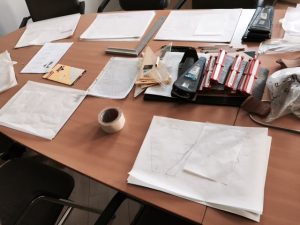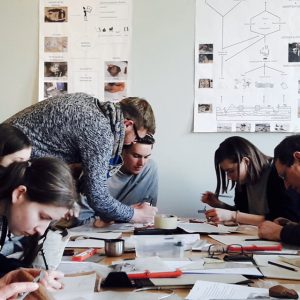Teaching theoretical and practical aspects of pottery processing (by Oliver Frank Stephan & Giulia D’Ercole)
Winter can be quite long and relatively boring in Munich, especially when compared to the time in the field and the spectacular recent discoveries coming day after day from Tomb 26 on Sai Island.
However, in Munich winter is also the time for teaching and for the annual winter semester AcrossBorders classes on practical archaeology. Following the successful experience of last year, we organized the second edition of the ‘AcrossBorders classes on Grabungsarchäologie’ for the students at LMU this current semester.
The main topic of this year was pottery, in all its forms, beginning with the theoretical aspects on ceramic and ending with the principal methodologies for pottery documentation and processing. Classes started in December with the first introductive lecture on Dec 8th, at which Julia Budka gave the students a comprehensive introduction on the theoretical aspects of pottery, with particular reference to the importance of pottery for dating structures and archaeological contexts.
In the following classes, students received a summary on Egyptian ceramics and the Vienna system, which is an essential tool for categorizing and macroscopically assessing different types of wares and clays. Oliver Frank Stephan, now on Sai Island for his fifth excavation season with AcrossBorders, illustrated to the students the main manufacturing techniques known in Egypt. He also discussed the different methods adopted by ancient Egyptian potters for firing their vessels and further presented the different styles of decoration, e.g. paintings, slips, incised wavy lines or applications. Finally, Giulia D’Ercole informed the students on the potential of recent archaeometric and technological methodologies for studying pottery, with reference to some of the principal analytical approaches used by archaeologists: petrographic, mineralogical and chemical laboratory analyses. The first series of classes ended with a theoretical lecture on pottery drawing.
The second step of this pottery-seminar was a two-day full immersion practical class, held in January at our project-office. With the students, we repeated and settled some of the main topics of our theoretical classes. Then the practical part started: each student was equipped with the materials we use for drawing pottery in the field and could experience in person how fascinating but challenging it can be to draw authentic ancient sherds! At the end of the day, with our helping hand and their excellent endurance – combined with the typical enthusiasm of the beginner – they were able to create very nice drawings!

 We closed our practical class with some other important processing steps that need to be done on excavation and in the office after the field season. These include photographic documentation of potsherds and small finds (e.g. scarabs or shabtis) and of course the digitalization of the drawn pots, making them ready for publication or further studies.
We closed our practical class with some other important processing steps that need to be done on excavation and in the office after the field season. These include photographic documentation of potsherds and small finds (e.g. scarabs or shabtis) and of course the digitalization of the drawn pots, making them ready for publication or further studies.
To sum up, the class was highly useful for both the students and us. They learned more about the importance of pottery in archaeological contexts and how to deal with it, theoretically and especially practically, by working “face to face” with original ceramic material from Sudan. We also had the nice opportunity to share our knowledge with others and hopefully pass on a bit of our passion towards pottery, sherds and lots of drawings.

Oh my dear Oliver every good nice topic. You know I Like Nubian Egyptian potery… more and more good luck. Huda